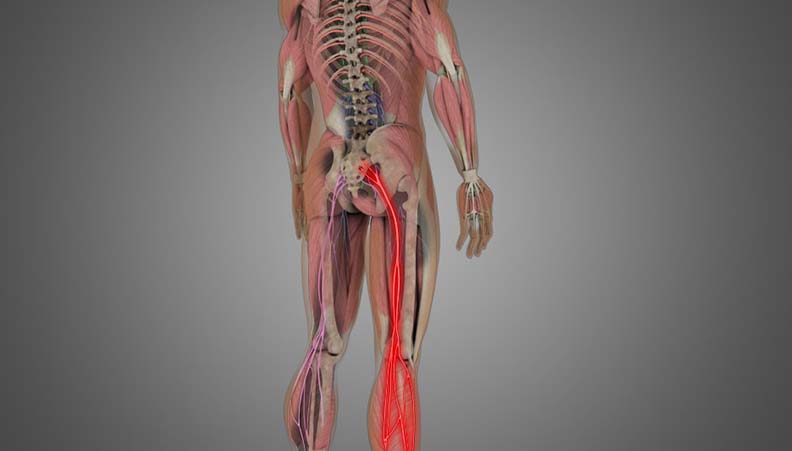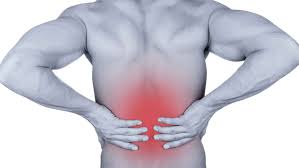Lumbar Radiculopathy is pain caused due to damage or irritation of the sciatic nerve originating in the buttocks. It is also referred to as Sciatica because the nerve roots which make the sciatica nerve is often involved. The sciatic nerve is the longest and thickest (about the width of a finger) nerve in the body. It actually consists of five nerve roots. Two are from the lower back region called the lumbar spine and three are from the lower part of the spine called the sacrum. Five nerve roots unite to form the left and right sciatic nerves. On each side of the body, the sciatic nerve passes through the lower back, buttocks, and one leg, ending just below the knee. The sciatic nerve branches into other nerves that travel down the leg to the feet and toes.
True sciatic nerve injury “sciatica” is rare, but the word “sciatica” is commonly used to describe pain that starts in the lower back and spreads to the legs. That is irritation, inflammation, pinching, or compression of the nerves in the lower back.
With “sciatica,” you feel mild to severe pain somewhere along the sciatic nerve. That means it can be anywhere from your lower back to your hips, buttocks, and/or legs.
This situation is caused by compression of the nerve roots exiting the spine, levels L1-S4. Compression can cause tingling, associated pain, numbness, paresthesia, and sometimes shooting pain. Radiculopathy can occur anywhere in the spine but is most common in the lower back (lumbar-sacral radiculopathy) and neck (cervical radiculopathy). It is less common in the middle part of the spinal cord (thoracic radiculopathy).
WHY CHOOSE SPECIALTY CARE CLINICS FOR TREATMENT?
There are surgical and non-surgical treatments for lumbar radiculopathy.
- Our doctors first consider non-surgical treatments. If you need surgery, see if minimally invasive surgery is right for you.
- Our doctors treat all types of nerve roots, including both chronic and acute forms of lumbar radiculopathy (lower back).
- Our spine specialists are trained and equipped to treat the most complex cases of lumbar radiculopathy.
- Treatment is the primary solution, and so is recovery. A customized rehabilitation plan allows you to return to your favorite activities after spinal surgery.
- Visit Specialty Care Clinics website or call us at 469-545-9983 to book an appointment with our specialist doctors.
SYMPTOMS OF LUMBAR RADICULOPATHY:
- Pain in the low back.
- Muscle weakness, pain, numbness, or tingling that travels into the buttocks, hip, groin, or leg.
- Muscle spasms.
- Back Pain Radiculopathy
WHAT IS LUMBAR RADICULOPATHY CAUSED BY?
Low back problems can be brought on by ageing, trauma, bad posture, excess body weight, and other factors. In turn, these issues could irritate nerve roots. They consist of:
- Damage to a lumbar spine disk. The adjacent nerve roots may then be pressed upon by the damaged disk.
- Age-related degeneration and wear and tear. The spaces between the vertebrae may result into stenosis. As the nerve roots emerge from the spinal canal, the constrictions put pressure on them.
- Spinal instability. A vertebra slides forward at this point. It may then apply pressure to a nerve root.
- The nerves in the lower back may also be compressed by other, uncommon occurrences. Diabetes, an infection, or a tumour are a few of them.
Sciatica
HOW TO TREAT LUMBAR RADICULOPATHY?
In most cases, doctors first try treatments to help relieve symptoms. This includes:
- Prescription and over-the-counter pain relievers. This help reduce pain, swelling, and irritation.
- Restrictions on positions and activities that increase pain. However, lying in bed and avoiding movement are only recommended for short periods of time.
- Physical therapy, including exercises and stretching. This reduces pain and improves movement and function.
- Steroid injection in the hip. This can temporarily relieve symptoms.
- Program for weight loss. If you are overweight, losing excess weight can help relieve symptoms.
- In some cases, surgery may be required to fix the underlying problem. This depends on the cause, symptoms, and duration of the pain.
HOW TO PREVENT LUMBAR RADICULOPATHY?
Lumbar radiculopathy cannot always be prevented and the condition may recur. How to protect your back:
- To keep your back strong, train your core muscles. Abdominal and lower back muscles are necessary for correct posture and alignment. Healthcare providers can recommend activities.
- Choose a seat with good back support, armrests, and a swivel. For better lower back support, place a pillow or rolled towel under your lower back to maintain your normal curvature. Keep your knees and hips horizontal.
- Occasionally place one foot on a stool or crate when standing for long periods of time. Use your legs when lifting heavy objects. Keep your luggage close to your body. Do not twist while lifting. Find someone to help you lift heavy or awkward objects.
Overall, lumbar radiculopathy is a very common complaint in clinical practice and accounts for the majority of annual physician visits. Because the majority of cases are benign and resolve spontaneously, conservative management is the most appropriate first step in the absence of clinical warning symptoms. Tests and nerve conduction studies can help diagnose.



